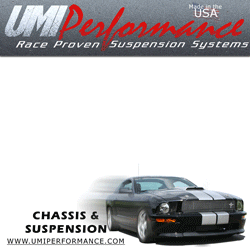Terry, I know that 18" wheels won't clear 15" rotor's..... but 15" rotor's would be an option for folks with 19" wheels.
No shit, really?
The front 14" BBK's with 6 piston rotor's was just a suggestion, since FRPP and Roush, etc, all offer them....albeit the price is double the 4 piston BBK's.
And they offer strut-tower braces, subframe connectors, rocker panel "ladder bars," carbon-fiber window switch trim, and 20" wheels. Better get the checkbook out.
Steeda offers a 13" rear rotor conversion kit..that uses the oem 1 piston rear caliper, some of the reviews on it were not too good. The GT-500 13.8" rear rotor conversion uses the same 1 piston oem rear caliper. It appears that both use a similar offset extension bracket to move the oem 1 piston caliper further out. I forget who makes the 14" rear rotor / 4 piston rear caliper setup, but saw a pix of it last year.
And exactly what problem is that designed to "fix"?
If 4" silicone brake hoses are used, you still have a bottleneck with the 3" fitting on the Boss 302 lower grille...and ditto with the 3" fitting on the 14" dust shields. If you morphed from 4" down to 3" at each end of the 4" hose, it would still flow more air, but I don't think very much more.
Or, you could just fab a 4" inlet and spindle duct...
Pentalab, you do know that Terry knows all this stuff, right? If you stop posting for a minute, and actually poked around his website (vorshlag.com), you'd see that they have MORE than adequate fab skills to graft 4" ducting into the front fascia, and in fact have been doing that on various projects (Brianne Corn's PPIR car for example) for quite a while. They can do more than just take a part out of a box and bolt it in place.
A few other factors for your consideration:
Besides adding mass (larger heat sump), a 15" rotor kit also adds a LOT of unsprung
rotating weight, AND greatly alters the torque bias between front and rear. Designing a proper brake package is NOT a matter of ticking the box on the webstore page with the biggest/most, it's balancing the thermal capacity with unsprung and rotating mass, while simultaneously keeping mechanical and hydraulic bias balanced.
More pistons in a caliper do NOT make the car brake better, or slow it down more quickly. The stock 2-piston floating caliper setup with 13" rotors is capable of putting the car into the ABS limit, and once that limit has been hit, throwing more clamping pressure at it is superfluous. Yes there are other factors involved, such as heat-sinking the fluid, or pad surface area for longevity, but there are also other solutions, like ducting air to the calipers if heat is an issue. IN MOST CASES, when you see a 6-piston setup on a street car, it's there for bragging rights at Cars 'N Coffee, not for any actual performance benefit. A properly cooled 14" 4-piston setup is more than sufficient in terms of heat-sink capability to survive hours of
continuous road-course duty under competition conditions (racing means NO cool-off laps mid session!), and provides an arguable and measurable performance edge over a 15" 6-piston setup. Think rotating mass to accelerate and decelerate, and you'll see what I mean.
Rear brakes: Once people find the "TCS OFF" button on track, rear brakes stop being a problem. They don't get hot enough to worry about, and even with the stock 12" rears, there is enough brake torque to balance the fronts in 13" or 14". If the rear brakes were such an issue, don't you think the $100,000+ Boss302/R would have something more back there? It doesn't, and competes successfully right out of the box. From a pure performance standpoint, the 14" rear conversion kit is there for one reason, and one reason only: to fill those ridiculously huge 19" wheels with brake rotor. In the end, it's an appearance mod, so that you don't have an acre of empty wheel barrel in back, with this tiny little peanut brake setup. Looking at 4-piston rears with a solid axle, that's again for bragging rights. If it's a radial-mounted fixed caliper, you'll have knock-back for DAYS as the axle play lets the rotor slide in and out. The only way that will work is with some kludged-together floating caliper mount, and again, you're adding mass to no purpose.
Seriously, guy, you only half-understand a lot of the concepts that you're pontificating about, frequently promulgate blatantly WRONG information, and make pretty ludicrous or bloody obvious suggestions on a fairly regular basis. Terry's advice is spot-on: Read more, post less (tm). And, in particular, post only when you have something SOLID, CORRECT, PROVABLE, and DEFENSIBLE to offer. Of course, questions are fair game.





